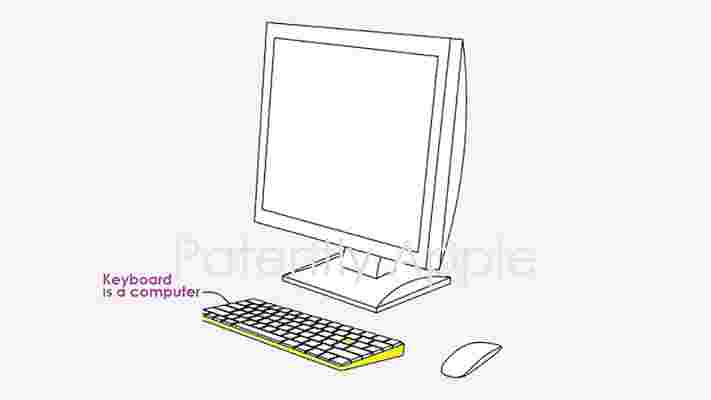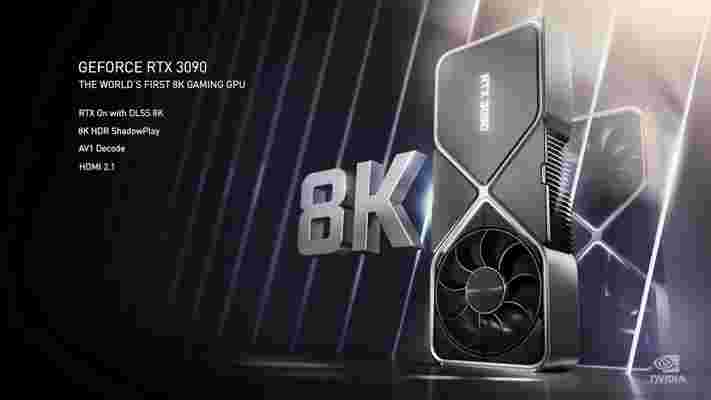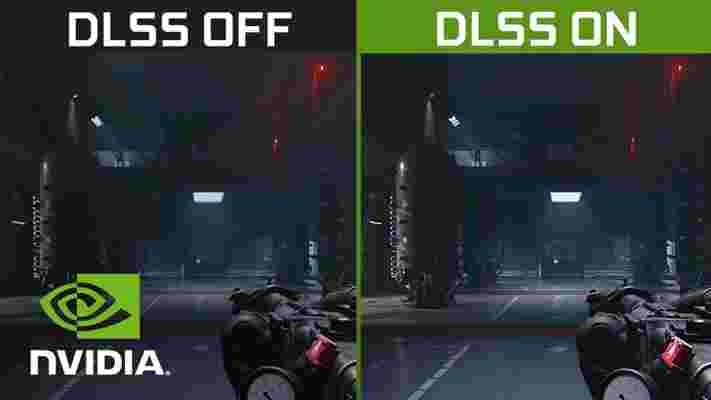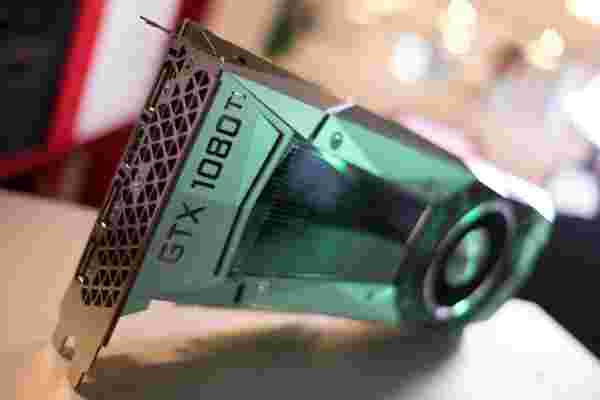Ideas outlined in patents don't always end up becoming actual products, but they can give us an interesting insight into what tech companies could be working on – and it would seem Apple is developing a Mac that fits inside a keyboard.
This is based on a patent spotted by Patently Apple (via 9to5Mac ), entitled Computer In An Input Device. Essentially, the key components – processor, memory, storage – all get embedded inside a keyboard.
The idea is that you could take this keyboard with you as you move between the home and the office (or wherever it is that you need a computer), plug it into a display, and load up macOS. It's sort of a Mac mini , in a keyboard shape.

Heat management
Obviously, packing everything inside a keyboard means there are going to be constraints in terms of performance, local storage, and so on. But for simple, day-to-day computing tasks, it would probably work just fine. After all, there's plenty of power in a smartphone.
The patent suggests that the keyboard could be manufactured from materials specifically designed to dissipate heat from the internal components. There would certainly have to be some clever airflow management with the electronics so tightly packed together.
A trackpad integrated into the keyboard is also mentioned in the patent filing, which would save you having to plug in a mouse. We'll have to wait and see whether this is one of those patents that eventually becomes a finished consumer device.
Analysis: the benefits of tiny computers
Computers built into keyboards are of course nothing new , as anyone who remembers owning a Sinclair ZX Spectrum or Commodore 64 will know. The modern day twist is that these keyboards can be made thinner and lighter than ever before.
That improves portability, so instead of having to find room for a laptop in your bag, you only have to find room for a keyboard – the trade-off being that there's no integrated display. You still need to find a monitor or a TV when you get to wherever you're going.
As the Mac mini and countless other tiny computers have shown, there's a lot of potential in these kinds of compact devices that you can take with you anywhere: from room to room, or office to office, or wherever it might be. All your files and apps move with you.
Apple already makes its own keyboards, though the Magic Keyboard might need some extra bulk to fit a complete computer inside. It's bound to appeal to many users, even if it's only going to be capable of basic tasks such as emailing or web browsing.
The Shokz OpenRun Pro are TechRadar's new top-rated running headphones
The Shokz OpenRun Pro have just taken the number one spot in our roundup of the best running headphones , and for good reason. These are headphones that prove you don't have to choose between sound quality and safety when you're hitting the trail or the pavement with your favorite tunes or podcasts – you can enjoy the best of both.
We love running here at TechRadar, and we're always excited to put a new set of headphones to the test. While some team members prefer running with noise-cancelling headphones that allow them to block out distractions and get into the zone, others prefer the spatial awareness you get with a bone conduction headset .
In the gym, you might want to totally muffle the club's choice of music and the sound of people dropping weights, but when you're running outdoors it's wise to stay aware of potential hazards like cyclists, cars, animals, and other pedestrians. Most noise-cancelling headphones has a 'transparency' mode that picks up these ambient noises and mixes it in with your music, which is great, but means it's not possible to tell exactly where the sound is coming from. You may be able to tell whether a siren is coming from the left or right, but is in in front of you, or behind?

Bone conduction headphones transmit sound to your auditory nerve by sending vibrations through your cheekbones, leaving your ear canals open. Cranking the volume right up will obscure your hearing, but if you keep your soundtrack at a reasonable level, you'll still be able to hear exactly what's happening around you and, importantly, where.
Move to the beat
The problem is that choosing a bone conduction headset usually means sacrificing sound quality for safety. Bass in particular tends to suffer, which is a real drawback if you rely on a driving beat to keep you motivated. It's proven that music can have a performance-enhancing effect during exercise , but tinny sound might just distract you.
That's where the Shokz OpenRun Pro come in. Shokz (formerly known as Aftershokz) has been in the running headphone business for many years, and over time its headsets have become lighter and more comfortable, with improved battery life too.
What sets the OpenRun Pro apart, though, is the addition of new bass transducers in each of the pads the transmit vibrations to your auditory nerve. It makes a world of difference, and means you no longer have to sacrifice rich sound in the interests of spatial awareness.
The OpenRun Pro are also a winner if you use a workout subscription service like Apple Fitness Plus, Peloton, or Amazon Halo. We've tested them using Les Mills On Demand's spinning classes, and the well balanced sound was excellent for delivering both the class leader's instructions and accompanying soundtrack.
The OpenRun Pro aren't quite perfect – when listening to particularly heavy music we found we could sometimes feel the vibrations – but that's a minor complaint, and something you might never experience if you're not a metalhead. It's also possible to adjust the EQ through the new Shokz mobile app (available for Android and iOS ) if you prefer to listen to audiobooks or podcasts on the move. If you're in the market for a new set of running headphones, they come highly recommended.
DLSS and FSR are the future of PC games, whether you like it or not
Back when Nvidia first revealed the GeForce RTX 2080 and showed the world what DLSS is and what it would do, it seemed like a good way to get more budget-oriented systems able to use the new-fangled ray tracing tech it debuted at the same time. Especially because the first iteration of Nvidia's AI upscaling tech wasn't exactly phenomenal it seemed to play second fiddle to a lot of other tech the company was pushing.
However, with the advent of the games generation brought about by the PS5 and Xbox Series X , there's a greater demand for visually rich games, loaded with ray tracing and otherwise complicated visuals. There's nothing I like more than a gorgeous gorgeous video game, but games have become way harder to run in just the last couple of years.
Even the RTX 2080 Ti , a graphics card that was an unstoppable 4K behemoth a few years ago, has become a 1080p GPU in most modern games that support ray tracing. And as the best PC games continue to get more complicated it's becoming more essential for them to include either DLSS or AMD's alternative - FidelityFX Super Resolution, or FSR.

Remember the 8K graphics card?
Every single time a high profile AAA game like the recently released Dying Light 2 comes out, I can't help but think back on the initial sales pitch for the Nvidia GeForce RTX 3090 , and how Nvidia swore that it was an 8K graphics card.
And while that's still technically true, you have to lower all the settings down to low and turn DLSS to performance mode to hit 60 fps at 8K. That's no way to live your life when you're spending thousands of dollars - especially at today's graphics card prices - on a GPU.
But even in other games, this remains true. Cyberpunk 2077 , for instance, even with the RTX 3090, can't be maxed out at 4K without relying on DLSS to get a playable framerate. It's just a blessing that at the same time, Nvidia has been able to improve the DLSS technology so much that I usually just turn it on by default in any game that offers it these days.
Even the mightiest graphics card on the market, then, needs DLSS to hit a solid frame rate at the resolution it's marketed for in the most demanding games.

Upscaling for everyone
I've been primarily a PC gamer for most of my life, and I still remember when Sony announced the PS4 Pro and showed off its checkerboard upscaling to hit 4K. Generally it worked quite well, but like any other PC gamer with access to a PC that could do 4K gaming, I scoffed. These consoles were advertising 4K gaming, but weren't actually playing games at a native 4K.
But guess what? Now that's most games, even on PC. Upscaling has become so good that it really doesn't matter what base resolution the game is being rendered at, because you really won't notice most of the time - especially if you're running FSR or DLSS at a "balanced" or "quality" preset.
This really struck me when I first started playing Dying Light 2, because I tried running it at 4K max with ray tracing effects enabled with the RTX 3090 and an Intel Core i9-12900K and it only got 40 fps. That's technically "playable" I guess, but I've been playing games at 60 fps for too long to settle for 40 fps in anything.
It's actually wild to me when I sit down and think about that too, because the rock-solid 60 fps standard that we as PC gamers have all subscribed to hasn't always been there, and it's only recently that I at least started to expect every game to hit it.

A link to the past
Going back 10 years or so, when we were trying to get our PCs to play Crysis or Metro 2033 or The Witcher 2, there were so many times that I just settled for 40 fps - and that was at 1080p. Playing at a rocky frame rate was just something you accepted because in order to even theoretically get 60 fps at high settings you'd have to start toying with multiple GPU setups or lowering the resolution and deal with a fuzzy image.
Even then, when you had the resources for a sick Crossfire or SLI setup and were able to hit a solid 60 fps, you were at the mercy of jittery frame times, as the connection between the two graphics cards didn't have enough bandwidth to seamlessly and smoothly play games without a ton of work from developers and the graphics card manufacturers themselves.
Back in the days when a lot of games were coming out as PC exclusives and were able to really reach for the skies in terms of graphics without having to worry about console compatibility, settling for sub-par performance was just a fact of life. And trying to push as close to 60 fps as you could and brag to your friends about how well you were able to run a game with the new graphics card you just bought.
And, with how hard games are to run right now, we could be in another era just like that. Especially with how hard 4K gaming is marketed right now - even though many people haven't moved beyond 1080p - there are so many games out right now that no one would be able to max out until the next generation of graphics cards came out.
But now that upscaling has blown up in such a huge way, no one has to suffer through the low framerates and weird jittery frame times that we had to deal with in the early 2000s and 2010s. It's made PC gaming a lot easier to deal with in general. It's just a shame that the increased accessibility this generation has been met by inflated prices for hardware.
Will it continue?
Both the GeForce RTX 3000 and Radeon RX 6000 series of graphics cards are the first generations to come out in this "next generation" of games. It's only natural for these cards to start to struggle as games are designed to take on more advanced hardware, and it's likely that the next generation of PC hardware is going to be able to hit high frame rates at high resolutions without necessarily needing upscaling to do it.
That's likely why Nvidia has started pushing tech like DLDSR as well as DLSS. DLDSR, or Deep Learning Dynamic Super Resolution , is the tensor-core powered version of DSR, something that already exists in the Nvidia Control Panel, where you can render a game at a higher resolution and then scale it down to your native resolution. This makes your game prettier and smoother-looking but will absolutely decimate performance.
The deep learning version of this is more efficient than brute forcing it through your regular shaders but it's still going to impact performance. So, it doesn't make much sense now, in a few years once, say, the RTX 4080 or RTX 5080 comes out, playing around with tech that makes games harder to run but prettier might start to make a lot of sense.
That's the scenario I'm hoping for. The last thing I want is for game developers or the GPU manufacturers themselves rely on upsampling tech as a crutch to push expensive and decadent graphics effects at all costs. That's the feeling I've been getting recently, but we're still early on in this gaming generation, so there's still time to prove me wrong.